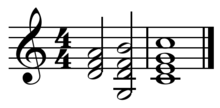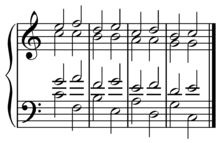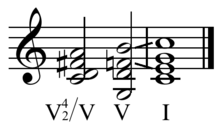- Predominant chord
-
In music theory, a predominant chord (also pre-dominant[1]) is any chord which normally resolves to a dominant chord[1]. Examples of predominant chords are the subdominant (IV), supertonic (ii), Neapolitan sixth and German sixth[1]. Other examples are the submediant (vi), secondary dominant (V/V), iv and ii°. The predominant harmonic function is part of the fundamental harmonic progression of many classical works.
 ii-V-I turnaround in C (
ii-V-I turnaround in C (
 Play (help·info)): the supertonic (dm) leads to the dominant (G7), which leads to the tonic (C).
Play (help·info)): the supertonic (dm) leads to the dominant (G7), which leads to the tonic (C).The dominant preparation is a chord or series of chords that precedes the dominant chord in a musical composition.[dubious ] Usually, the dominant preparation is derived from a circle of fifths progression. The most common dominant preparation chords are the supertonic, the subdominant, the V7/V, the Neapolitan chord (N6 or ♭II6), and the augmented sixth chords (e.g., Fr+6).
 The circle progression features a series of chords derived from the circle of fifths preceding the dominant and tonic.
The circle progression features a series of chords derived from the circle of fifths preceding the dominant and tonic.
In sonata form, the dominant preparation is in the development, immediately preceding the recapitulation. Ludwig van Beethoven's sonata-form works generally have extensive dominant preparation — for example, in the first movement of the Sonata Pathétique, the dominant preparation lasts for 29 measures (mm. 169-197)[citation needed].
See also
Sources
- ^ a b c Benward & Saker (2009). Music in Theory and Practice: Volume II, Glossary, p.359. Eighth Edition. ISBN 978-0-07-310188-0.
Chords By type Major · Minor · Dominant · Dominant seventh flat five · Diminished · Half-diminished · Diminished major · Minor-major · Augmented major · Augmented minor · Nondominant · Harmonic seventh chordAdded
/ omittedBy function SecondaryWith names Elektra chord · Farben chord · Hendrix chord · Mu chord · Mystic chord · Northern lights chord · Petrushka chord · Power chord · Psalms chord · So What chord · Spider chord · Tristan chord · Viennese trichord · Dream chordOther Common chord (music) · Mixed interval · Open chord · Polychord · Primary triad · Quartal and quintal · Slash chord · Subsidiary chord · Synthetic chord · Tone cluster
This music theory article is a stub. You can help Wikipedia by expanding it.




